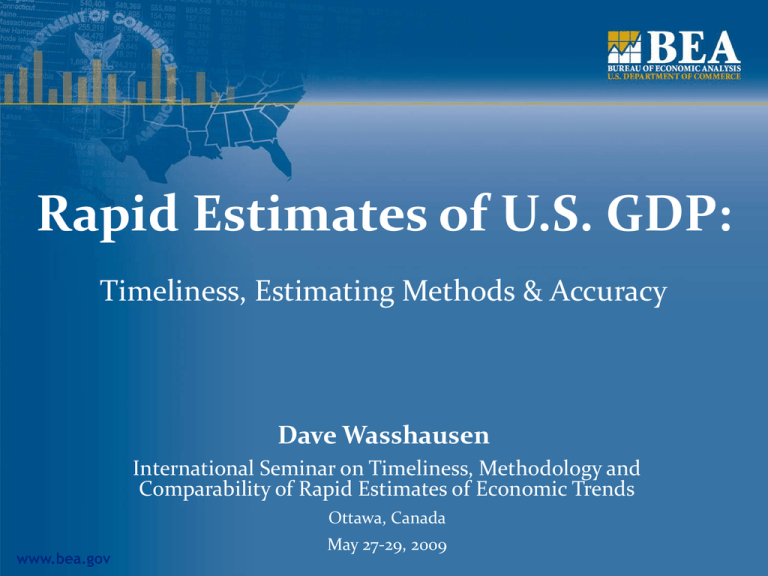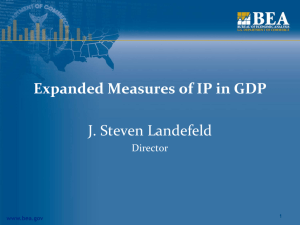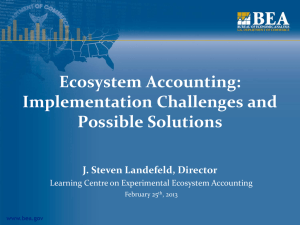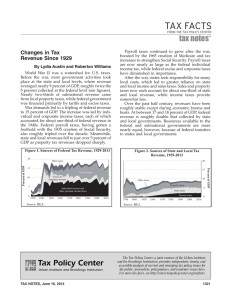Rapid Estimates of U.S. GDP: Timeliness, Estimating Methods & Accuracy Dave Wasshausen
advertisement

Rapid Estimates of U.S. GDP: Timeliness, Estimating Methods & Accuracy Dave Wasshausen International Seminar on Timeliness, Methodology and Comparability of Rapid Estimates of Economic Trends Ottawa, Canada www.bea.gov May 27-29, 2009 Timeliness ▪ “Advance” estimates of GDP released toward the end of the first month after the end of the quarter. Based on partial source data and BEA assumptions Complete set of expenditures estimates; partial set income estimates Corporate profits and net interest are not prepared due to insufficient source data www.bea.gov 2 Timeliness ▪ Tradeoff between quality and timeliness Try to strike the appropriate balance between accuracy and timeliness BEA releases several “vintages” of GDP estimates, each subsequent vintage based on better source data www.bea.gov 3 Share of Source Data for Quarterly Estimates of GDP www.bea.gov 4 Source Data for Advance Estimate ▪ Three months of source data are available for: Consumer spending on goods Shipments of capital goods excluding aircraft Motor vehicle sales and inventories Manufacturing durables inventories Federal government outlays Consumer, producer and international prices ▪ Only two months of data are available for most other key source data (including construction spending, foreign trade, & remaining inventory series) www.bea.gov 5 Estimating Methods ▪ Retail Control Method ▪ Commodity Flow Method ▪ Price-Times-Quantity Method ▪ Judgmental Trend ▪ Imputations www.bea.gov 6 Revisions and Accuracy ▪ Revisions and accuracy are related, but not the same Some of the most inaccurate data have never been revised Some of the most accurate data are subject to regular revisions ▪ Revisions must be judged against average growth and volatility in growth ▪ Publish regular revision studies (Feb. 2008) www.bea.gov 7 Revisions ▪ Single largest source of revisions is updating of seasonal factors ▪ Largest source of revisions in trend growth is changes in concepts, methods, and source data intended to update the accounts and improve accuracy. www.bea.gov 8 Accuracy ▪ Current quarterly estimates of real GDP correctly indicate: Direction of change 98 percent of the time Whether accelerating or decelerating 74 percent of the time Whether growth is above, near, or below trend growth more than three-fifths of the time. ▪ Estimates have also been shown to be unbiased, with no identifiable bias from the introduction of real time data www.bea.gov 9 Comparisons of Revisions to GDP Vintages compared Advance to preliminary… Advance to final………… Advance to latest………. Average Average without regard to sign Current-dollar GDP 0.2 0.5 0.2 0.7 0.4 1.1 Real GDP Advance to preliminary… Advance to final………… Advance to latest………. www.bea.gov 0.1 0.1 0.3 0.5 0.6 1.2 10 Revisions to Real GDP estimates Real GDP Growth Rate: Quarters, 2008 4.0 3.3 2.8 1.9 2.0 0.6 0.9 1.0 0.9 0.0 -0.3 -0.5 -0.5 -2.0 -4.0 -3.8 -6.0 -6.2 -6.3 -8.0 08Q1 www.bea.gov 08Q2 Advance Preliminary 08Q3 Final 08Q4 Annual Revision 11 Revisions to GDP for QII, QIV ▪ Large changes in energy prices (upward in QII, downward in QIV). Wedge between GDP and Gross domestic purchases prices. Inventory valuation adjustment. ▪ Difficulty of projecting data for the missing month. ▪ Importance of publishing “key assumptions.” www.bea.gov 12 Conclusion ▪ BEA’s goal: Early estimates that provide users with a useful “snapshot” of the economy (in the aggregate and by component) ▪ BEA’s early estimates do a relatively good job providing an overall picture of economic activity. In general, they tell us: www.bea.gov If the economy is expanding or contracting If growth is accelerating or decelerating If growth is high or low relative to trend What major components are contributing to growth The timing of business cycle peaks and troughs 13





